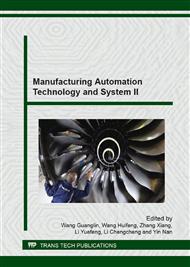p.456
p.462
p.470
p.476
p.482
p.493
p.499
p.505
p.513
Design of a Spool Valve Overlap Value Pneumatic Measuring System Based on Constant Pressure Control
Abstract:
Pressure type pneumatic measuring is the most wildly used method in overlap value testing, which depends strongly on the constant pressure of gas supplying. However,control of pressureisrarely done before.This paper presentsa design of a new overlap value measuring system with pressure control sub-system, mechanical platformand a program-controlled sub-system. A hybrid controller is developed combined with fuzzyself-adjusting PID and time-optimal control. The final version of this controller is a computationally efficient analytic scheme suitable for implementation in thereal-time closed-loop pressure digitalcontrol. At last, the system control software developed on LabVIEW is briefly introduced.
Info:
Periodical:
Pages:
482-489
Citation:
Online since:
August 2014
Authors:
Price:
Сopyright:
© 2014 Trans Tech Publications Ltd. All Rights Reserved
Share:
Citation:


